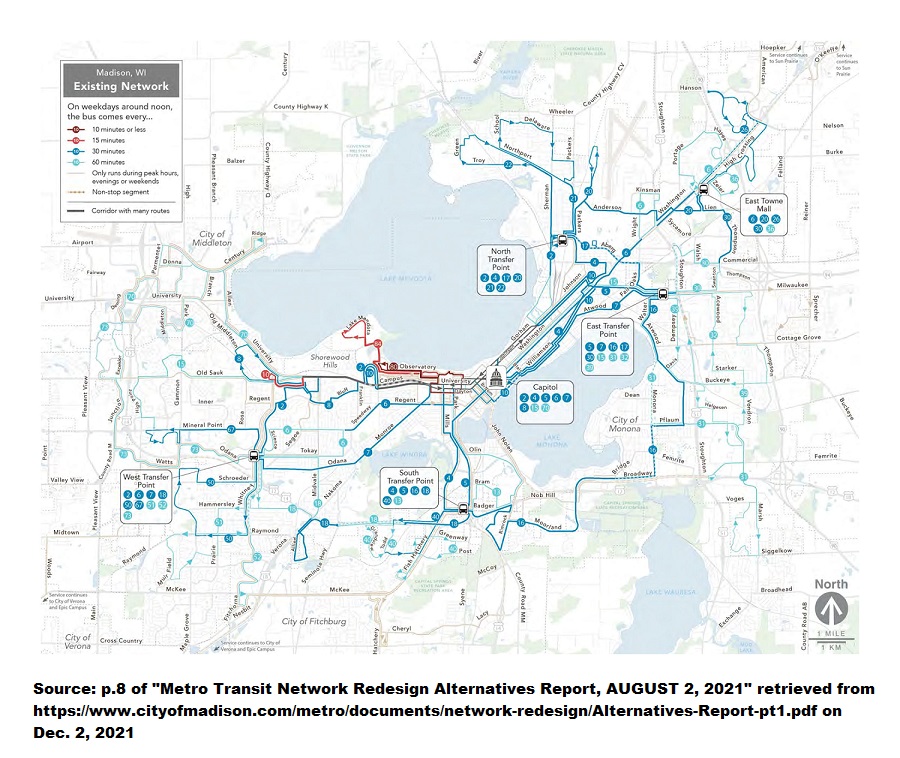Follow the Transit Money or Why Half-Assed Does not Work
Susan De Vos | December 3, 2021


Killing and Stealing in Clear Daylight You have heard variations on this theme before: The City of Madison is dismantling its bus system in the name of improving it by way of a costly "network redesign study" that adds Bus Rapid Transit to its regular bus service. Both systems are supposed to operate on the same level of funding that was allotted exclusively for local operations before. That is, a new Bus Rapid Transit run will use 20-25% of the funds that previously went to local bus service while the local bus will operate at 75-80% of its previous funding level. And as a consequence, huge swaths of the city, including older inner neighborhoods and newly constructed peripheral neighborhoods, will lose access to the bus in order to pay for much more frequent service on much fewer lines. Other trips that used to involve one ride will now require a number of transfers, a particularly unpleasant prospect in the middle of winter. Only the most captive audience will put up with that kind of "improvement," justifying the system's total elimination. The city-imposed funding level of "no increase" is despite the recent adoption of an extra $40 Vehicle Registration Fee (VRF or "Wheel Tax") pushed by many under the mistaken belief that it would enable proper funding of an expanded transit system. That the extra VRF revenue was in truth mainly designed to fund city agencies other than Metro Transit or that federal grants for Bus Rapid Transit would only help fund capital costs but not daily operations, was never hidden from the public. But the reality was adroitly glossed over or finessed while widely expounded misinformation was left uncorrected. Now that the ugly truth is coming out that people are going to lose their bus service entirely or become forced to make multiple transfers, the city no longer has the option of raising more revenue with the Vehicle Registration Fee Will the city finally be bold enough to offset additional transit costs by proactively identifying possible "shovel ready" projects to be funded by likely future state or federal grants? So far, indications are not promising. City department and agency managers are selected to be reactive, not proactive. They are continually being directed to shave budget requests, encouraged to "cut corners" when nobody is looking and told to look for further "efficiencies" from a stone already squeezed dry. The future for public transportation in Madison does not look bright. Borrowing for Roads While Under-Funding Transit Even a lay person can see how borrowing for roads is all out of proportion to what our priorities are. Take for example figures in a summary "statement of indebtedness and debt service" relating to the 2022 city budget. That statement lists what Madison's outstanding debt will be on January 1, 2022 and the nine major "reasons" for that debt. The debt will be $364,796,763. Over half the debt (56.9%) is for 'streets.' The second largest reason for the debt (parks improvements) accounts for a tenth (10.7%). Debt is nothing new, but how it bites into the Operating Budget is. According to a recent newspaper article, "The city's annual debt costs have risen from 12% of the general fund budget in 2011 to roughly 17% in the current year and about the same in 2023." An earlier article actually took us back a decade before that and showed how City spending on roads was increasing exponentially year after year even as spending on parks and community services remained flat. While a certain amount of funding for "streets" would seem reasonable, perhaps involving the reconstruction of a road that had reached its end life, other spending is unnecessary and would be better spent on identifying and instituting road diets, more sustainable transportation modes or just not spent at all. Actually, a well-funded transit system makes economic sense. Public transportation nationally has a return of $5 for every dollar spent. In Wisconsin specifically, a very dated figure has it closer to $3 to $1. Three is still a significant return, belying the notion that public transportation is a drain on the economy. It seems pertinent therefore that one of the first things Madison's current mayor did after being sworn in to office was to hand over $1.99 million to the County Executive to pay for the expansion of Cottage Grove Road from two to four lanes. The County would chip in $1.21 million and the Feds $3.45 million for a project that in total was estimated to cost $6.65 million. That the county would help fund public transportation on the road was not part of the deal. (In fact, none of the revenue from the county's own $28 VRF is going toward public transportation.) With spending like that, should it be any surprise that the City of Madison is looking at an $18 million deficit in the 2022 budget? Yes, there had been calls for the reconstruction of Cottage Grove Road for years, but the reconstruction did not have to include an expansion that facilitated more driving into Madison from Cottage Grove by car and the extra Vehicle Miles Traveled (VMT) that entails.
Fully Fund an Improved Public Transit System |